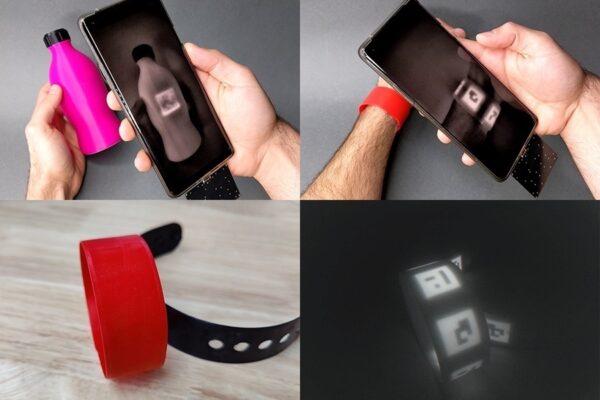In Augmented Reality and Virtual Reality News
September 11, 2023 – Researchers at MIT’s Computer Science and Artificial Intelligence Laboratory (CSAIL) – a laboratory of over 900 researchers, including professors, research scientists, postdocs, PhDs, master’s students and undergrads – have recently unveiled ‘BrightMarker,’ invisible fluorescent tags embedded in physical objects to enhance motion tracking, virtual reality, and object detection. According to MIT, BrightMarker potentially offers a new dimension of data connectivity and user security between the physical and digital worlds.
Whilst QR codes can be replaced or tampered with by malicious actors to direct unsuspecting users to harmful links or malware, MIT researchers stated that BrightMarkers can essentially act as “hidden” tags for objects that offer tamper-proof metadata embedding, with the potential to enhance both security and user experience. Researchers also stated that BrightMarkers could open up possibilities for more interactive engagements with everyday objects.
To create a BrightMarker, users download a software plugin for 3D modeling programs like Blender, where they can embed the tag within their design. The 3D-printed object, fabricated with fluorescent filaments, contains the hidden tag, similar to an invisible QR code. The markers emit light at a specific near-infrared wavelength, making them visible to specialized cameras and hardware setups. These setups, designed for smartphones, augmented reality (AR), and virtual reality (VR) headsets, can detect and scan the markers, and can therefore integrate physical and digital information, according to MIT.
Furthermore, the BrightMarkers are imperceptible to the naked eye — and unobtrusive, meaning they do not alter an object’s shape, appearance, or function. This makes them tamper-proof while seamlessly embedding metadata into the physical world. MIT noted that by adding a layer of connectivity between data and physical objects, users would have access to a more interactive experience with the world around them.
In VR settings, objects with embedded BrightMarkers could become interactive tools within a virtual environment, and could open up the potential for creating even more immersive experiences for users.

“In a future dominated by the AR and VR paradigm, object recognition, tracking, and traceability is crucial for connecting the physical and digital worlds: BrightMarker is just the beginning,” said MIT CSAIL visiting researcher Raúl García-Martín, who is doing his PhD at the University Carlos III of Madrid. “BrightMarker’s seamless tracking marks the start of this exciting journey into a tech-powered future.”
MIT CSAIL also asserted that the tags have the potential to be used in supply chain tracking, where manufacturers could scan the tags to gather metadata about an object’s origin and movement. Consumers could also use BrightMarkers to verify product authenticity, similar to proposed initiatives like the European Union’s Digital Product Passports, according to the researchers.
“BrightMarkers serve as gateways to ‘ubiquitous metadata’ in the physical realm,” explained Mustafa Doğa Doğan, a PhD candidate at MIT CSAIL. “This term refers to the concept of embedding metadata — descriptive information about the object’s identity, origin, function, and more — directly into physical items, akin to an invisible digital signature accompanying each product.”
“The fluorescent filaments emit a light that can be robustly filtered using our imaging hardware,” addedDoğan. “This overcomes the ‘blurriness’ often associated with traditional embedded unobtrusive markers, and allows for efficient real-time tracking even when objects are in motion.”
Also commenting on the research, Google research scientist Mar Gonzalez-Franco (who was not involved in the work) stated: “Immersive technologies require powerful scene understanding capabilities. Having invisible markers embedded, like the ones from BrightMarker, can simplify the computer vision needs and help devices identify the objects that are interactable and bridge the gap for the users of AR and VR.”
The researchers are set to present their findings on BrightMarkers at the Association for Computing Machinery’s User Interface Software and Technology Symposium (UIST), which is taking place in San Francisco from October 29-November 1, 2023.
To read the full blog announcement on MIT’s CSAIL BrightMarkers and how the technology might be applied to AR and VR experiences, click here.
Image / video credit: MIT CSAIL HCI Engineering Group / YouTube
About the author
Sinead Chloe
Sinead is a freelance copywriter and marketing professional. She has many years of experience in covering industries including tech, utilities, and the environmental sector.
